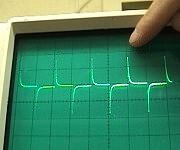 |
 Return to Methods List |
Methods in Neuroscience Whole Cell Patch Clamp Technique - MAKING A SEAL |
| Below are photos of some key steps in forming a seal on the cell membrance and then using suction to break into the "whole cell" recording mode. |
|
Forming a seal & making a whole cell recording Click HERE for an audio recording explaining what the oscilloscope will look like as the seal forms. Click HERE for a short video explaining the traces in the first panel below (2.6 MB). Click HERE for a video showing formation of a Gohm seal and getting a whole cell recording (10 MB). |
||
 The top trace is the current response of the electrode in the bath. The bottom trace shows the small voltage step that is being applied repeatedly. |
 As the seal begins to form, the horizontal lines of the current trace move closer together (compare to previous photo). |
 Here is the current response when the pipette is on the cell and a seal has begun to form. This photo was taken from the computer monitor. It shows the response to only 1 voltage step. |
 Tobias is gently sucking on the back of the syringe that is connected to the back of the pipette. This suction will help seal the tip of the pipette onto the cell. |
 Here is the current response to a series of small voltage steps when the pipette has formed a tight seal on the cell membrane. Compare this photo to the one directly above it. The vertical "spikes" in the current trace are currents due to the pipette capacitance. |
 The amplifier is used to compensate, i.e. to electronically remove, the pipette capacitance from the current recording. |
 After electrically removing the pipette capacitance, the vertical spikes are gone. |
 To break into the whole cell recording mode, additional suction is applied to the syringe. As shown here, you'll know when a whole cell recording in acheived because the capacitative transients (the vertical "spikes" due to the cell capacitance) are large and have a slow decay. |
 When the seal degrades and the cell becomes leaky, the baseline of the recording drops (see how it is below zero) and the small test voltage step produces a larger current response than when the seal was tight. |
| Overview | Web Lectures | Fellowships | Activities | Home | SFN | NAS | IBRO |